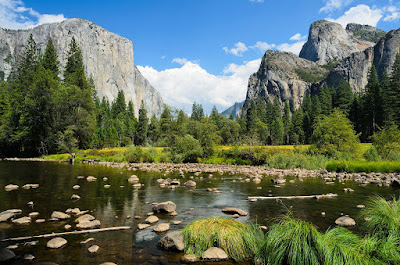Yosemite National Park
_________________________________________________________________________________
The Tuolumne and Merced River systems originate along the crest of the Sierra Nevada in the park and have carved river canyons 3,000 to 4,000 feet (910 to 1,220 m) deep. The Tuolumne River drains the entire northern portion of the park, an area of approximately 680 square miles (1,800 km2). The Merced River begins in the park's southern peaks, primarily the Cathedral and Clark Ranges, and drains an area of approximately 511 square miles (1,320 km2).
Hydrologic processes, including glaciation, flooding, and fluvial geomorphic response, have been fundamental in creating landforms in the park. The park also contains approximately 3,200 lakes (greater than 100 m2), two reservoirs, and 1,700 miles (2,700 km) of streams, all of which help form these two large watersheds. Wetlands in Yosemite occur in valley bottoms throughout the park, and are often hydrologically linked to nearby lakes and rivers through seasonal flooding and groundwater movement. Meadow habitats, distributed at elevations from 3,000 to 11,000 feet (910 to 3,350 m) in the park, are generally wetlands, as are the riparian habitats found on the banks of Yosemite's numerous streams and rivers.
Bridalveil Fall flows from a U-shaped hanging valley that was created by a tributary glacier.
Yosemite is famous for its high concentration of waterfalls in a small area. Numerous sheer drops, glacial steps and hanging valleys in the park provide many places for waterfalls to exist, especially during April, May, and June (the snowmelt season). Located in Yosemite Valley, the Yosemite Falls is the highest in North America at 2,425 feet (739 m). Also in Yosemite Valley is the much lower volume Ribbon Falls, which has the highest single vertical drop, 1,612 feet (491 m). Perhaps the most prominent of the Yosemite Valley waterfalls is Bridalveil Fall, which is the waterfall seen from the Tunnel View viewpoint at the east end of the Wawona Tunnel. Wapama Falls in Hetch Hetchy Valley is another notable waterfall. Hundreds of ephemeral waterfalls also exist in the park.

0 Comments
Post a Comment